Site pages
Current course
Participants
General
Module 1. Basic Concepts, Conductive Heat Transfer...
Module 2. Convection
Module 3. Radiation
Module 4. Heat Exchangers
Module 5. Mass Transfer
Lesson 11. Fin Efficiency and effectiveness, Problems on fins
Convection:
As discussed earlier in Lesson-1, transfer of heat between a fluid and a solid surface occurs by convection which is a combination of conduction and mass transport. When a cold fluid comes in contact with a hot solid surface, heat transfer takes place by convection mode and it involves
Flow of heat from solid surface to fluid particles in contact with it by conduction resulting in increase in temperature and internal energy of fluid particles.
Movement of heated particles to low temperature region and transfer of heat to low temperature fluid particles.
Therefore, in convection, transfer of heat is dependent on fluid motion which could be laminar or turbulent. In case of laminar flow, heat is transferred between fluid layers by molecular motion on submicroscopic level. In case of turbulent flow, heat transfer mechanism is modified and aided by formation of eddies which result in movement of fluid particles across streamlines. These fluid particles mix with other fluid particles and transfer energy. Heat transfer rate by convection increases with increase in inter mixing or in other words turbulence.
Free Convection:
If motion of heated fluid particles occurs due to density differences resulting from temperature variation, heat transfer process is termed as free convection. Heating of a liquid in a vessel placed on a stove is an example of free convection heat transfer process as shown in Figure 1.
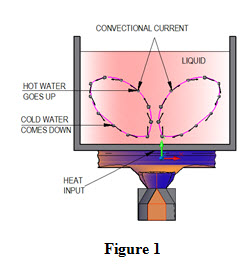
Forced Convection:
If motion of heated fluid particles is caused by some external source such as a fan, blower or a pump, then heat transfer process is termed as forced convection. The heating of air by blowing it over electric coils in a heater and cooling of air by blowing it over cooling coils in an air conditioner are examples of forced convection as shown in Figure 2.

Newton’s Law of Cooling:
During study of cooling of fluids, Newton observed that convection process plays a more prominent role when a fluid and a solid surface exchange heat as compared to pure conduction. He proposed fundamental heat convection equation which is expressed as
q = h A (Ts – Tf) (1)
where
q is average rate of heat transfer by convection, W or J/sec
A is heat transferring area, m2
Ts is temperature of solid surface, oC
Tf is temperature of fluid, oC
h is an average value of proportionality constant called convective heat transfer
coefficient, W/(m2-oC)
Convective heat transfer coefficient, h:
It is not a fluid property but its value depends upon the following parameters
i. Surface geometry
ii. Nature of fluid flow
iii. Bulk fluid velocity
iv. Thermo-physical properties such as thermal density, specific heat, viscosity and thermal conductivity of fluid
Typical values of convective heat transfer coefficient are given in Table 1.
Table 1: Value of Convective Heat Transfer Coefficient ( W/(m2-K))
|
Type of Convection |
Gases |
Liquids |
|
Free Convection |
2-25 |
10-1000 |
|
Forced Convection |
25-250 |
50-20,000 |
|
Boiling and Condensation |
2500-10000 |
|
Non- Dimensional Numbers:
i) Reynolds Number: Reynolds number is a measure of relative magnitude of inertia force to viscous force occurring in a flow. Higher is the value of Reynolds number, greater will be inertia force and vice-versa. Reynolds number is defined as the ratio of inertia force to viscous force and is expressed as
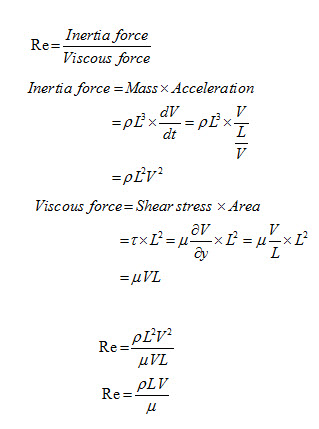
ii) Prandtl Number: It is defined as the ratio of kinematic viscosity to thermal diffusivity and is denoted by ‘Pr’.
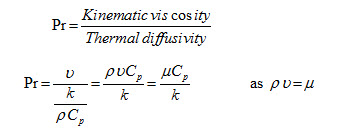
Kinematic viscosity indicates impulse transport through molecular friction and thermal diffusivity indicates heat transport through conduction. Prandtl number signifies the relative speed with which momentum and energy are propagated through a fluid.
iii) Nusselt Number: It is defined as the ratio of heat flow rate by convection under unit temperature gradient to the heat flow rate by conduction under unit temperature gradient through a stationary thickness ‘L’.

iv) Stanton Number: Stanton number is defined as ratio of Nusselt number to the product of Reynolds and Prandtl numbers and is denoted by ‘St’.

v) Peclet Number: Peclet number is defined as ratio of mass heat flow rate to heat flow rate by conduction under unit temperature gradient through a thickness of ‘L’.
Mass heat flow rate = Heat capacity of fluid passing through a unit cross-sectional area per unit time
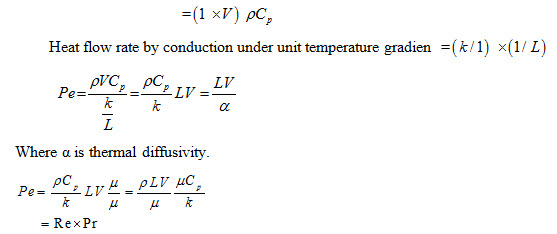
vi) Gratez Number: It is defined as the ratio of heat capacity of a fluid flowing through a pipe per unit length to the conductivity of the pipe material.
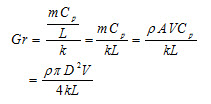
vii) Grashoff Number: It is defined as the ratio of product of inertia force and buoyancy force to square of viscous force.
